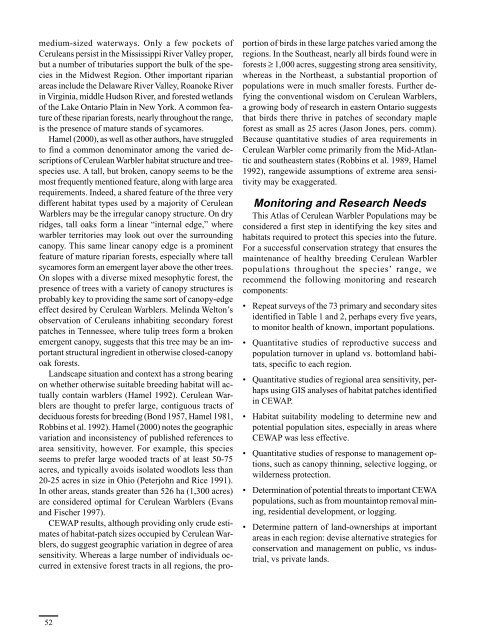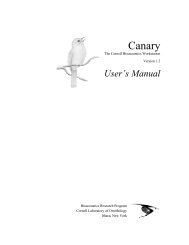An Atlas of Cerulean Warbler Populations - Cornell Lab of Ornithology
An Atlas of Cerulean Warbler Populations - Cornell Lab of Ornithology
An Atlas of Cerulean Warbler Populations - Cornell Lab of Ornithology
Create successful ePaper yourself
Turn your PDF publications into a flip-book with our unique Google optimized e-Paper software.
medium-sized waterways. Only a few pockets <strong>of</strong><strong>Cerulean</strong>s persist in the Mississippi River Valley proper,but a number <strong>of</strong> tributaries support the bulk <strong>of</strong> the speciesin the Midwest Region. Other important riparianareas include the Delaware River Valley, Roanoke Riverin Virginia, middle Hudson River, and forested wetlands<strong>of</strong> the Lake Ontario Plain in New York. A common feature<strong>of</strong> these riparian forests, nearly throughout the range,is the presence <strong>of</strong> mature stands <strong>of</strong> sycamores.Hamel (2000), as well as other authors, have struggledto find a common denominator among the varied descriptions<strong>of</strong> <strong>Cerulean</strong> <strong>Warbler</strong> habitat structure and treespeciesuse. A tall, but broken, canopy seems to be themost frequently mentioned feature, along with large arearequirements. Indeed, a shared feature <strong>of</strong> the three verydifferent habitat types used by a majority <strong>of</strong> <strong>Cerulean</strong><strong>Warbler</strong>s may be the irregular canopy structure. On dryridges, tall oaks form a linear “internal edge,” wherewarbler territories may look out over the surroundingcanopy. This same linear canopy edge is a prominentfeature <strong>of</strong> mature riparian forests, especially where tallsycamores form an emergent layer above the other trees.On slopes with a diverse mixed mesophytic forest, thepresence <strong>of</strong> trees with a variety <strong>of</strong> canopy structures isprobably key to providing the same sort <strong>of</strong> canopy-edgeeffect desired by <strong>Cerulean</strong> <strong>Warbler</strong>s. Melinda Welton’sobservation <strong>of</strong> <strong>Cerulean</strong>s inhabiting secondary forestpatches in Tennessee, where tulip trees form a brokenemergent canopy, suggests that this tree may be an importantstructural ingredient in otherwise closed-canopyoak forests.Landscape situation and context has a strong bearingon whether otherwise suitable breeding habitat will actuallycontain warblers (Hamel 1992). <strong>Cerulean</strong> <strong>Warbler</strong>sare thought to prefer large, contiguous tracts <strong>of</strong>deciduous forests for breeding (Bond 1957, Hamel 1981,Robbins et al. 1992). Hamel (2000) notes the geographicvariation and inconsistency <strong>of</strong> published references toarea sensitivity, however. For example, this speciesseems to prefer large wooded tracts <strong>of</strong> at least 50-75acres, and typically avoids isolated woodlots less than20-25 acres in size in Ohio (Peterjohn and Rice 1991).In other areas, stands greater than 526 ha (1,300 acres)are considered optimal for <strong>Cerulean</strong> <strong>Warbler</strong>s (Evansand Fischer 1997).CEWAP results, although providing only crude estimates<strong>of</strong> habitat-patch sizes occupied by <strong>Cerulean</strong> <strong>Warbler</strong>s,do suggest geographic variation in degree <strong>of</strong> areasensitivity. Whereas a large number <strong>of</strong> individuals occurredin extensive forest tracts in all regions, the proportion<strong>of</strong> birds in these large patches varied among theregions. In the Southeast, nearly all birds found were inforests ≥ 1,000 acres, suggesting strong area sensitivity,whereas in the Northeast, a substantial proportion <strong>of</strong>populations were in much smaller forests. Further defyingthe conventional wisdom on <strong>Cerulean</strong> <strong>Warbler</strong>s,a growing body <strong>of</strong> research in eastern Ontario suggeststhat birds there thrive in patches <strong>of</strong> secondary mapleforest as small as 25 acres (Jason Jones, pers. comm).Because quantitative studies <strong>of</strong> area requirements in<strong>Cerulean</strong> <strong>Warbler</strong> come primarily from the Mid-Atlanticand southeastern states (Robbins et al. 1989, Hamel1992), rangewide assumptions <strong>of</strong> extreme area sensitivitymay be exaggerated.Monitoring and Research NeedsThis <strong>Atlas</strong> <strong>of</strong> <strong>Cerulean</strong> <strong>Warbler</strong> <strong>Populations</strong> may beconsidered a first step in identifying the key sites andhabitats required to protect this species into the future.For a successful conservation strategy that ensures themaintenance <strong>of</strong> healthy breeding <strong>Cerulean</strong> <strong>Warbler</strong>populations throughout the species’ range, werecommend the following monitoring and researchcomponents:• Repeat surveys <strong>of</strong> the 73 primary and secondary sitesidentified in Table 1 and 2, perhaps every five years,to monitor health <strong>of</strong> known, important populations.• Quantitative studies <strong>of</strong> reproductive success andpopulation turnover in upland vs. bottomland habitats,specific to each region.• Quantitative studies <strong>of</strong> regional area sensitivity, perhapsusing GIS analyses <strong>of</strong> habitat patches identifiedin CEWAP.• Habitat suitability modeling to determine new andpotential population sites, especially in areas whereCEWAP was less effective.• Quantitative studies <strong>of</strong> response to management options,such as canopy thinning, selective logging, orwilderness protection.• Determination <strong>of</strong> potential threats to important CEWApopulations, such as from mountaintop removal mining,residential development, or logging.• Determine pattern <strong>of</strong> land-ownerships at importantareas in each region: devise alternative strategies forconservation and management on public, vs industrial,vs private lands.52
















